

UNITED STATES HARBOR DEFENCES - USCG CABLE SHIPS
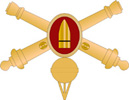 |
The Army Cable Ship Joseph Henry
(Later the Thalis o Milisios) The Last Sister Ship Afloat |
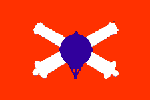 |
This page is about the cable ship Joseph Henry, built in 1909. Her story is related to that of the U.S. Coast Guard Cable ship Pequot and their role in vital antisubmarine harbor defense along the eastern seaboard of the USA during World War II. On this page you'll see a comparison in the design and construction of the Henry to the Pequot and to several of the Pequot's sisterships. Our main page for the USCG Pequot provides extra details about the ship, its crew, its purpose as well as links to our other Pequot pages. You can also read about the Pequot's sisterships at Pequot Sisterships. Research and design by by Chip Calamaio and Richard Walding.
JOSEPH HENRY - CONSTRUCTION 1909
In 1909 when the Pequot, was under construction as the mine planter General Samuel M Mills, at the New York Shipbuilding company in Camden, New Jersey, about 300 miles away the cable ship Joseph Henry was being built at the New Port News Shipbuilding and Dry Dock company in New Port News, Virginia.
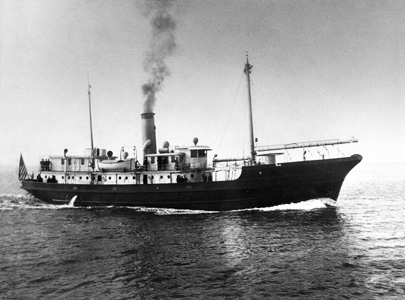 |
| The US Army Cable Ship Joseph Henry (Huntington Ingalls Industries - Newport News Shipbuilding) |
What made the Henry different from the Mills and her identical sister ships the Frank and Schofield is that the Joseph Henry was specifically built as a cable laying ship for the War Department’s US Army Submarine Cable Service of the Army Signal Corps, while the Mills, Frank and Schofield were contracted by the Army Quartermaster Corp (General) for mine planting operations. It should be noted that throughout her 38 years of Army service the Henry was given the prefix "CS" for Cable Ship rather than the more common "USS". This clearly stated the intention of the ship’s mission as a cable layer since it was constructed in 1909.
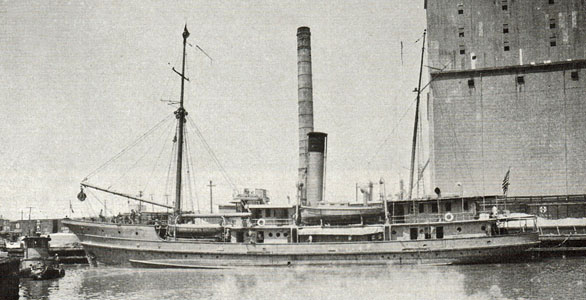 |
|
2. A view of the Henry’s port side. (atlantic-cable.com) |
The resemblance between these ships is striking and the dimensions of the hulls were almost identical. When first constructed all of the Henry’s superstructure appears to closely match the main deck cabins, wheelhouse, and rear stateroom cabins of the Mills, Frank and Schofield.
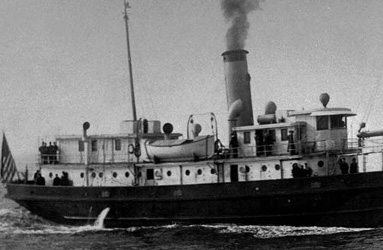 |
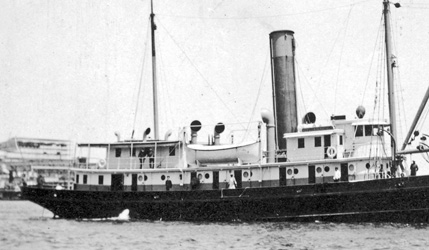 |
| 3. The superstructure of the CS Joseph Henry (Newport News Shipbuilding Apprentice Alumni Association) |
4. The near identical superstructure of the John
Schofield (US Naval Institute) |
The main difference was the profile of the Henry’s bow and fo'castle deck which were designed for cable laying operations. In addition to two bow mounted cable sheaves the forward deck was designed to accommodate a large spool of cable mounted horizontally.
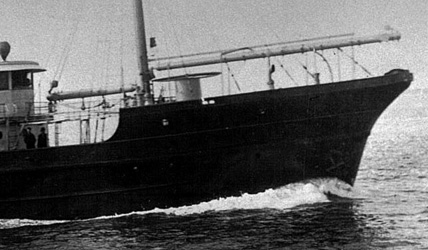 |
 |
| 5. The cable ship Joseph Henry from wheelhouse to bow as first constructed. (Newport News Shipbuilding Apprentice Alumni Association) |
6. The mine planter Samuel M. Mills from bow to wheelhouse as first constructed (Independence Seaport Museum Archives) |
So even though the Joseph Henry was built under a separate contract at a different shipyard we wonder if much of the ship was designed by the same naval architect and constructed from very similar specifications as the three mine planters with the exception of the forward part of the ship which was configured for a cable laying mission rather than mine planting.
After she was commissioned in 1909 the Henry served for 38 years as a versatile cable layer for the US Army and often laid cables associated with mine planting operations in addition to general submarine communications cable work.
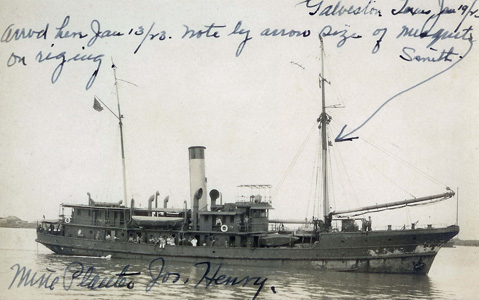 |
|
7. CS Joseph Henry Galveston, Texas
January 1923. (Randy Biddle) |
We’ve obtained a unique photo of the Joseph Henry in Galveston, Texas in January of 1923. Signed by "Smith" the note written on the print points out that the "musquito" (mosquitos) in Texas are the size of the Henry’s mast mounted running light in the rigging. Despite the joke it is interesting to see more than 30 men on deck in this shot and that the Henry is described here as a mine planter rather than a cable ship. Even though she was built as a cable ship due to parallel yet similar missions the Henry was taken into the Army’s Mine Planter Service before WWII, while in 1922 the Army Mine Planter the General Samuel M. Mills was converted to the cable ship Pequot for the Coast Guard.
|
|
For an additional historical perspective on the Army Mine Planter Service of the 1900s Click Here to go to Ramon Jackson’s Ghost Fleet website. |
John J Miller, former Commanding Officer of the Joseph Henry during WWII, has contributed to an in-depth series of webpages on the history of the ship and her cable missions during the war years.
 |
Click Here to access Marty Dwyer’s research project homepage and Miller’s extensive first person account of the Henry’s contribution during WWII. |
In reviewing the Henry’s history and Miller’s first hand recollections we see that during much of WWII the Joseph Henry was based out of the Boston Army base and was extensively involved in cable laying and repair operations, yet no reference is made to any loop cable work. So even though this ship was working on harbor defense, communication, and mine planting cable assignments often in the same waters as the Pequot as an Army ship it does not appear the Henry was involved in the Navy’s top secret indicator loop mission as executed by the Coast Guard’s Pequot to protect Atlantic ports and harbors. We do see that, like the Pequot, the Joseph Henry often had to repair undersea cables that were damaged or cut by the anchors of merchant ships who were part of the supply convoys to England and Russia.
JOSEPH HENRY - POSTWAR
After WWII the Joseph Henry was sold to the Greek Government in 1947
and renamed the Thalis o Milisios. She became a
cable ship for the government-owned Hellenic Telecommunications
Organization (OTE) and was active
into the 1980s laying and repairing cable in the Aegean Sea to maintain the
network of undersea cables which inter-connect the Greek Isles. The ship was retired in 1983 and was to be sold for
scrap by the Greek government. After eight years the ship was rescued and
donated in the early 90s as a floating museum to the Aegean Maritime Museum
at Trocadero Quay in Palaio Faliro, Athens, Greece.
 |
|
8a. The Thalis o Milisios as a floating museum ship in Athens, Greece. (nautilia.gr) |
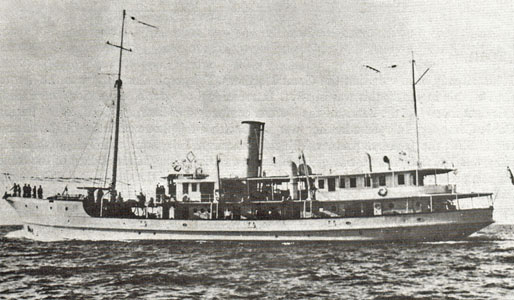 |
|
8b. Seen here in the early 1960s the Thalis o Milisios was responsible for laying and maintaining more than 100 undersea cable runs which connected communities throughout the Greek Isles. (from Haigh's Cableships and Submarine Cables) |
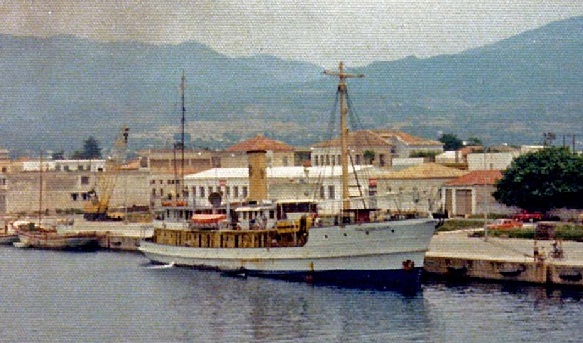 |
|
8c. Seen here in 1975 during her working years as a Greek cable layer the Thalis o Milisios had a white and tan superstructure. (atlantic-cable.com) |
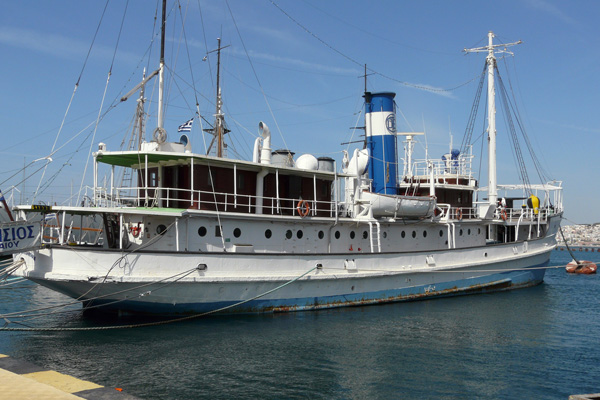 |
|
9. The starboard side of the Thalis o Milisios berthed for museum tours (Photo by Vounisios) |
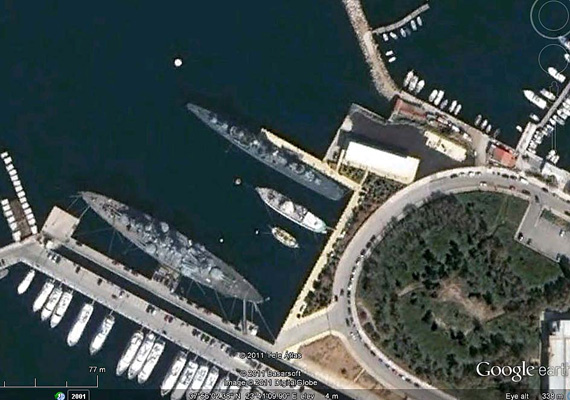 |
|
10. In this Google Earth view we see today that the Thalis o Milisios and the small sailing ship Evagelistria are berthed between the Greek armored cruiser the Georgios Averof and the HNS Velos D-16, which is the ex-US Navy Fletcher Class destroyer USS Charrette (DD-581). |
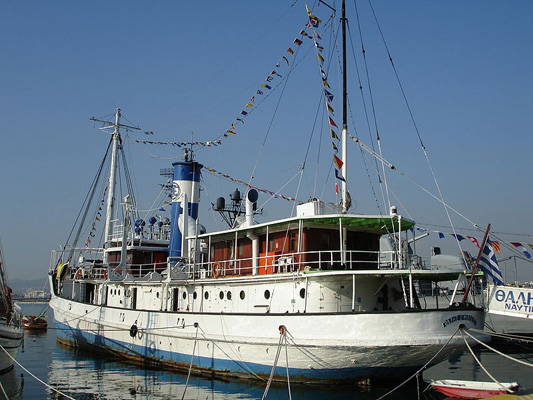 |
|
11. Of high interest to our research project is that the Thalis o Milisios is the last ship of the Pequot’s era still afloat. Much of the ship appears identical to Pequot and has remained unchanged for more than 100 years. The only other physical evidence that remains of these Army mine planters and cable ships which were built in the early 1900s is the wreck of the Royal T. Frank which lies in deep water off the coast of Hawaii and has never been located. |
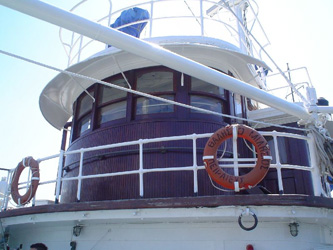 |
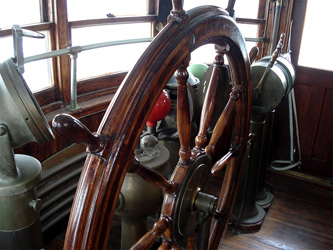 |
|
12. Like the Mills, Schofield and Frank we see curved awnings protect the ship’s pilothouse windows. (nautilia.gr) |
13. Inside we see a beautiful carved wooden helm in front of a classic compass binnacle with distinctive red and green iron adjustment spheres. To the left is an early generation gyrocompass with adjustable magnifying lens similar to Pequot’s (nautilia.gr) |
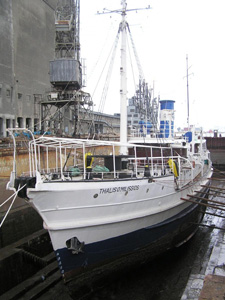 |
 |
|
14 & 15. In 2007 the ship was again drydocked and extensively renovated. We see that as the Thalis o Milisios the fo’castle area up to the bow and the rear upper cabin and stern were fitted with sun shades during the ship’s long years of service in the sunny Greek isles. A pipe structure to lash awnings in place was added over the entire fo’castle deck and permanent porch like covers were installed aft on both levels. Before WWII many ships were routinely designed with removable awnings including the Pequot. |
|
Since the Thalis o Milisios is available for public viewing it
provides a rare opportunity to see the interior of one of these ships
since we have located only a few photos inside the Pequot’s wheelhouse,
cabins, and below deck.
 |
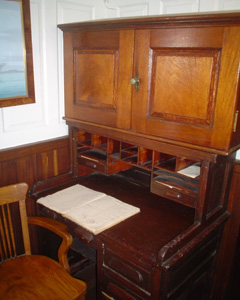 |
| 16. It appears this upper deck cabin has been outfitted as a chart room with a large table for nautical charts used during cable installation work. (nautilia.gr) | 17. A Yeoman’s desk (nautilia.gr) |
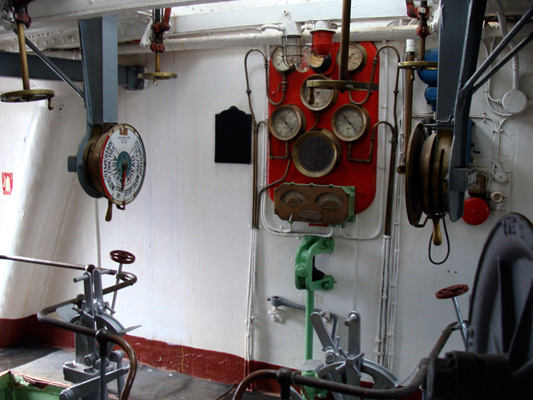 |
|
18. The engineering control deck. Despite decades of service in Greece we see that the Telegraph wheel remained in English. (nautilia.gr) |
 |
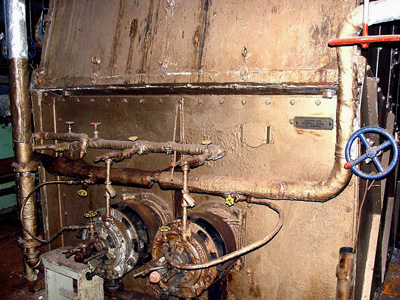 |
| 19. A look at the steam engine below decks. (nautilia.gr) | 20. We also see that at some point the ship was converted to burn oil instead of coal to generate steam. (nautilia.gr) |
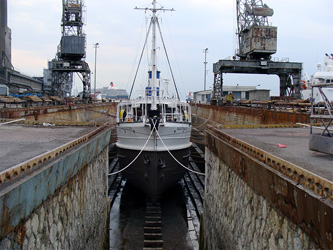 |
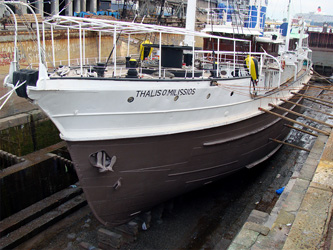 |
| 21. In 2007 the ship was dry docked. (nautilia.gr).... | 22. ...and repaired and repainted. (nautilia.gr) |
 |
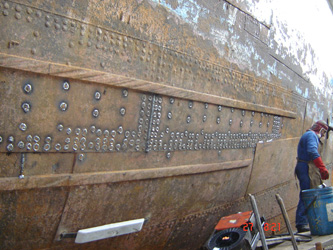 |
| 23. A worker draining the forward trim tank during repair work to the ship’s hull. (Newport News Shipbuilding Apprentice Alumni Association) | 24. Restoration included the tedious job of welding many hull rivets (Newport News Shipbuilding Apprentice Alumni Association) |
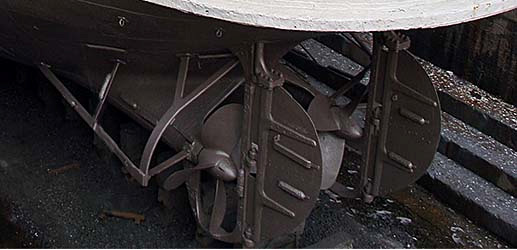 |
|
25. During the 2007 renovation work the ship’s reinforced twin rudders and cable guarded propellers were restored and repainted (nautilia.gr). |
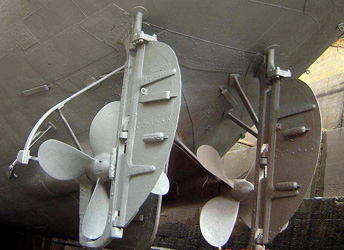 |
 |
|
26 & 27. Those twin four bladed screws and dual rudders made the ship extremely manoeuvrable for precise cable laying work. (nautilia.gr) |
|
 |
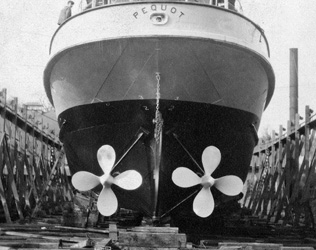 |
|
28 & 29. The four-bladed props on Pequot and the other 1909-era mine layers also were built with guards to keep cables from becoming entangled in the propellers but these ships only had one rudder. (Independence Seaport Museum Archives; US Coast Guard History Office, respectively) |
|
 |
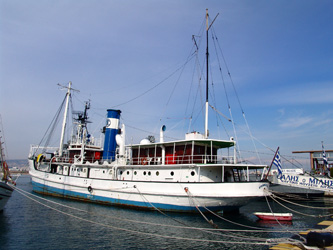 |
| 30. The “OTE” logo of the Greek telecommunications company is now painted on the stack (Marina Trokadero Palaion, Faliron, Athens Greece) | 31. The fully restored ship in it’s new role as a floating museum (nautilia.gr) |
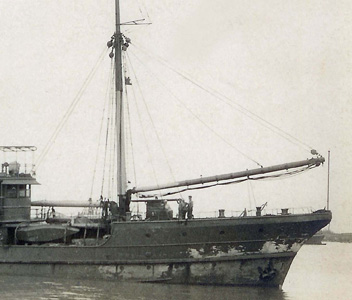 |
 |
|
32. When first constructed the Henry had two large booms off the main mast and fairly complex rigging to operate them. (Randy Biddle) |
33. By the time the ship served in the Greek Isles just a single small boom was rigged to the forward mast. (nautilia.gr) |
 |
To download an article with additional information on this ship see Bill Lee’s history of the Joseph Henry as prepared for the Newport News Shipbuilding Apprentice Alumni Association Click Here. |
 |
|
34. After more than 100 years the ship can still steam under its own power. (Newport News Shipbuilding Apprentice Alumni Association) |
MEET THE PEQUOT'S SISTER SHIPS
For stories about the crew and history of the USCG Pequot please go to the USCG Pequot main page.
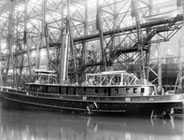 |
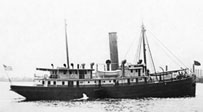 |
 |
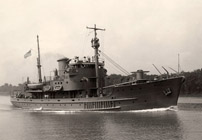 |
 |
| Gen. John M Schofield | Gen. Royal T Frank | Gen. Wm M Graham | 2nd Gen Sam M. Mills | 2nd Gen. Royal T Frank |
| Click on the image above to go to the ship. | ||||
Every effort has been made to trace and acknowledge
copyright. The authors would welcome any information from people who believe
their photos have been used without due credit.
Some photos have been retouched to remove imperfections but otherwise they
are true to the original.
FEEDBACK
If you have comments or queries specifically
about the Pequot or her Sister Ships, please contact
Chip Calamaio
chipaz@cox.net, 938 E. San Miguel Avenue, Phoenix, 85014, Arizona,
USA. (H) 602-279-4505.
Click here to go to the Pequot Main Page.
Research and design: Chip Calamaio and Richard Walding